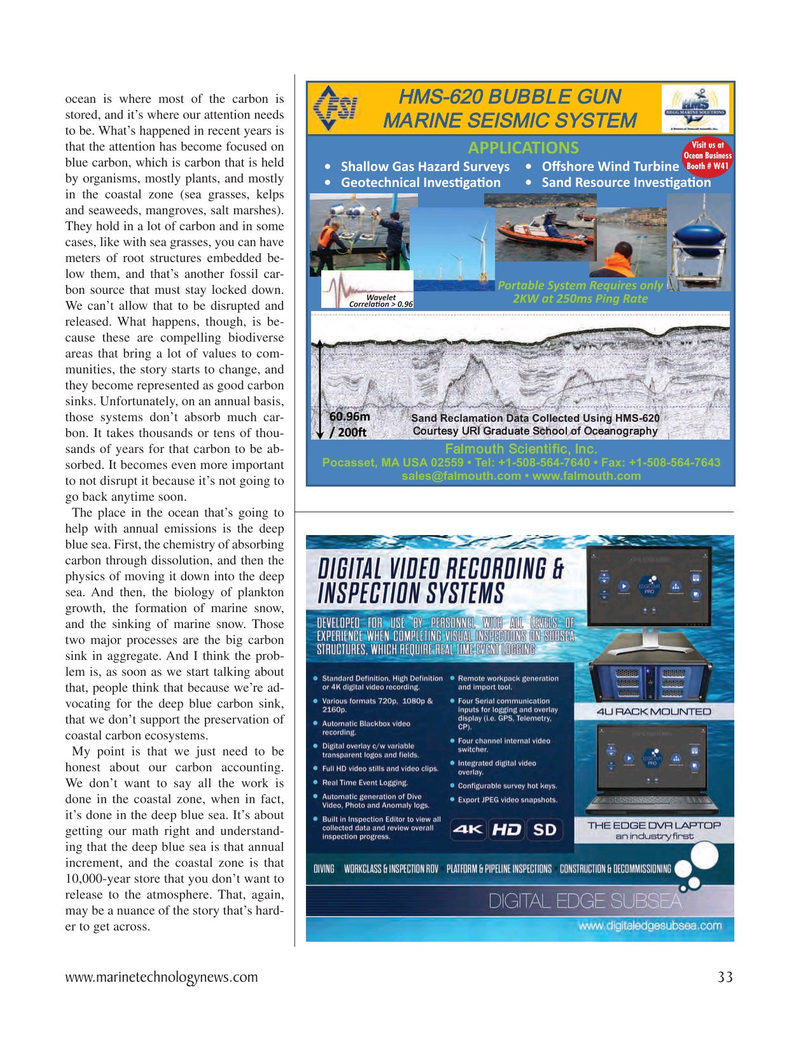
Page 33: of Marine Technology Magazine (March 2023)
Read this page in Pdf, Flash or Html5 edition of March 2023 Marine Technology Magazine
ocean is where most of the carbon is
HMS-620 BUBBLE GUN stored, and it’s where our attention needs
MARINE SEISMIC SYSTEM to be. What’s happened in recent years is
Visit us at that the attention has become focused on APPLICATIONS
Ocean Business blue carbon, which is carbon that is held
Booth # W41 • Shallow Gas Hazard Surveys • Oi shore Wind Turbine by organisms, mostly plants, and mostly • Geotechnical InvesO gaO on • Sand Resource InvesO gaO on in the coastal zone (sea grasses, kelps and seaweeds, mangroves, salt marshes).
They hold in a lot of carbon and in some cases, like with sea grasses, you can have meters of root structures embedded be- low them, and that’s another fossil car-
Portable System Requires only bon source that must stay locked down.
Wavelet 2KW at 250ms Ping Rate
CorrelaO on > 0.96
We can’t allow that to be disrupted and released. What happens, though, is be- cause these are compelling biodiverse areas that bring a lot of values to com- munities, the story starts to change, and they become represented as good carbon sinks. Unfortunately, on an annual basis, those systems don’t absorb much car-
Sand Reclamation Data Collected Using HMS-620
Courtesy URI Graduate School of Oceanography bon. It takes thousands or tens of thou- sands of years for that carbon to be ab- Falmouth Scienti¿ c, Inc.
Pocasset, MA USA 02559 • Tel: +1-508-564-7640 • Fax: +1-508-564-7643 sorbed. It becomes even more important [email protected] • www.falmouth.com to not disrupt it because it’s not going to go back anytime soon.
The place in the ocean that’s going to help with annual emissions is the deep blue sea. First, the chemistry of absorbing carbon through dissolution, and then the physics of moving it down into the deep sea. And then, the biology of plankton growth, the formation of marine snow, and the sinking of marine snow. Those two major processes are the big carbon sink in aggregate. And I think the prob- lem is, as soon as we start talking about that, people think that because we’re ad- vocating for the deep blue carbon sink, that we don’t support the preservation of coastal carbon ecosystems.
My point is that we just need to be honest about our carbon accounting.
We don’t want to say all the work is done in the coastal zone, when in fact, it’s done in the deep blue sea. It’s about getting our math right and understand- ing that the deep blue sea is that annual increment, and the coastal zone is that 10,000-year store that you don’t want to release to the atmosphere. That, again, may be a nuance of the story that’s hard- er to get across.
www.marinetechnologynews.com 33
MTR #3 (18-33).indd 33 3/17/2023 6:06:23 PM

 32
32

 34
34
